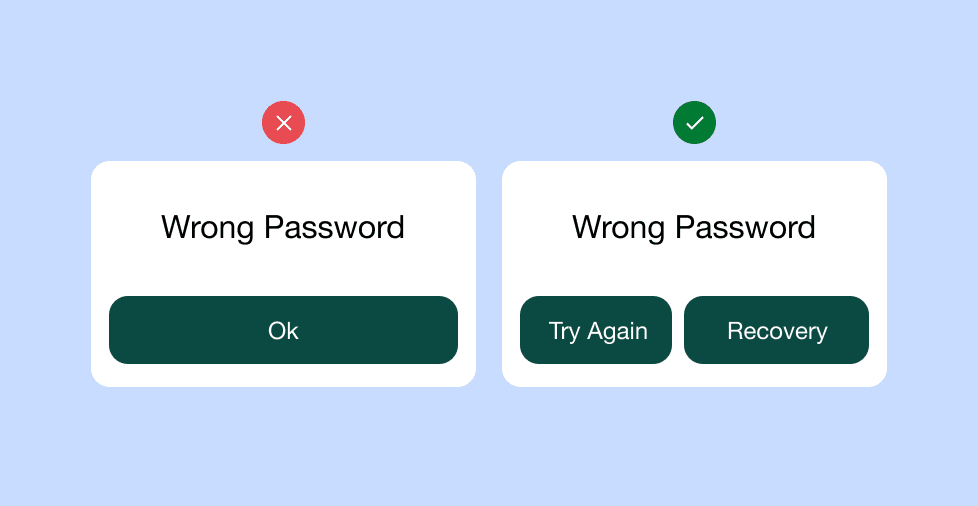Key takeaways:
- UX copywriting shapes how people interact with your website by guiding their actions.
- Clear, concise, and empathetic copy improves user experience.
- Traditional copywriting focuses on persuasion; UX copywriting focuses on usability and guiding user action.
Imagine landing on a well-designed website but still unsure about where to go or what to do next. The buttons are vague, the headlines are confusing, and before long, you click away. Many small businesses pay too much attention to a website’s visuals and sometimes neglect the words that enhance the user’s experience.
That’s where UX copywriting comes in. Well-executed UX copywriting helps shape how people move through a website, making their experience feel natural and intuitive rather than confusing or overwhelming.
But what is UX copywriting? This article breaks it down, explains how it differs from traditional copywriting, and explores the key elements and tips you can use to improve your UX copy.
What is UX copywriting?
UX copywriting is a form of copywriting that focuses on creating content and text for user interfaces. It is key in guiding users, providing information, and facilitating their interaction with your product or website.
To understand it further, let’s dissect the term and take a closer look.
What is user experience (UX)?
User experience refers to the overall impression someone has when they interact with your website, app, or digital product. User experience isn’t just about the design; it also means the user can easily navigate, understand the information, and complete tasks without a hitch.
If a visitor can quickly find information, complete a form without hassle, or make a frictionless purchase, they’ve had a positive user experience. On the other hand, confusing navigation, unclear instructions, or unnecessary steps can leave them frustrated.
Good UX is about removing barriers and making every interaction feel natural. It combines design, functionality, and language to create a straightforward and enjoyable user journey.
What is copywriting?
Copywriting is the process of writing text to persuade, inform, or motivate people to take a specific action, these written contents are called “copies.” You’ll often see them in website headlines, product descriptions, social media ads, and email campaigns.
Unlike general writing, copywriting is tied directly to a business objective, whether getting someone to click a button, sign up for a service, or purchase. It combines creativity with strategy, using words to inform and drive results.
Good copywriting bridges the gap between what your audience needs and what your business offers. When done well, it captures attention, effectively communicates value, and encourages people to take the next step.
Combining UX and copywriting means your copies guide users to have a seamless journey while interacting with your website or application.
What are examples of UX copywriting?
In practice, UX copy looks like the following examples:
- Error messages. Instead of a vague “Error 404,” a well-crafted UX copy might say, “Oops! This page seems to be lost. Let’s get you back on track.”
- Buttons. Rather than a plain “Submit” button, UX copy might use “Sign Up Now” or “Get Started,” which are more action-oriented and encourage users to click.
- Form labels. Instead of “Name,” you might see “What should we call you?” which is more engaging and friendly.
- Product descriptions. Effective UX copy can help users understand a product’s value. For instance, “Get more done in less time with our time-saving app” is more engaging than a bland description.
- Microinteractions. When you hover over a button that changes color, a small message like “Click to learn more” gives clarity and guides the user.
UX writers collaborate closely with UX designers to ensure that every word is chosen carefully and that the overall content meets the user’s needs. This partnership results in a copy that’s easy to understand and guides users through their digital journey.
What is a UX copywriter?
A UX copywriter is a skilled writer who specializes in writing text for user interfaces. They blend user research, effective writing, and teamwork to create valuable web content for users and businesses.
Below are the key responsibilities of a UX writer:
- Research. UX writers begin by understanding the users, the product, and the overall experience. This involves reviewing user data, studying behavior patterns, and collaborating with designers and product teams. The goal is to uncover what users need, how they think, and what language best supports their journey. Strong research ensures the copy is not just clear, but genuinely helpful and aligned with user goals.
- Copywriting. UX writers are wordsmiths with a purpose. They compose copies that influence users’ online experience. From button texts to product descriptions, every word is thoughtfully chosen to engage and assist users in navigating seamlessly.
- Collaboration. UX copywriters are team players. They work with various departments—marketing, design, development, legal, and business development—to ensure that the words are consistent with the branding, overall UX design, business’s legal standards, and the marketing strategy.

Why is UX copywriting important?
Attention is the new currency; UX copywriting plays a vital role in capturing and keeping it. UX copywriting is important because it:
- Shapes user behavior and decisions
- Elevates clarity, engagement, and trust
- Reduces cognitive load and frustration
- Maximizes product adoption and customer satisfaction
Let’s take a closer look:
Shapes user behavior and decisions
The words you encounter on a website, app, or product aren’t random. UX writers strategically craft these copies with a specific goal in mind. From persuasive calls-to-action on landing pages to clear instructions within digital products, every word aims to steer user behavior and influence decisions.
Elevates clarity, engagement, and trust
Clear, engaging, and trustworthy content is the core of UX copywriting. Users should be able to understand a digital product quickly and effortlessly. When the right words resonate, they can translate into a more positive perception of your brand.
Reduces cognitive load and frustration
Complexity is the bane of a great user experience. A well-crafted UX copy simplifies interactions, which helps reduce cognitive load. Users who navigate easily and without frustration are more likely to stick around and purchase your offerings.
Maximizes product adoption and customer satisfaction
Effective UX writing ensures users adopt your product or service seamlessly. When the copy aligns with their intent and leads them on a smooth journey, it maximizes product adoption and ultimately boosts customer satisfaction.
Lastly, it’s worth noting that the right words can be the difference between customer frustration and satisfaction.
How to make better UX copy
Customers are constantly bombarded with marketing messages from all sides. They’re tired of being sold to and more likely to tune out generic, uninspired copy. If your copy isn’t persuasive and engaging, you’re missing out on a huge opportunity to connect with customers and build brand awareness.
Follow these UX copywriting tips that can make a significant difference in your content strategy:
- Use plain language and avoid jargon
- Maintain a consistent tone and voice
- Align with both brand values and user needs
- Demonstrate empathy and understand the user’s context
- Follow best practices for microcopy
Let’s examine each of them further:
Pro tip 1: Use plain language and avoid jargon
User experience thrives on clarity. Complex, jargon-filled language can confuse and frustrate users. Instead, use simple language that users can easily understand. When writing, imagine explaining your content to someone who knows nothing about your industry.
Pro tip 2: Maintain a consistent tone and voice
Consistency is key to creating a unified user experience. Your copy should maintain a consistent tone and voice across all touchpoints, from your website to social media posts. For example, if your brand is known for being friendly and approachable, ensure that your copy conveys this same warmth and personality across platforms.
Pro tip 3: Align with both brand values and user needs
Your copy should strike a balance between your brand’s values and the specific needs of your users. It’s about speaking the language of your audience while staying true to your brand’s mission. You can do this by researching what your audience values and needs. This research will make your copy more relatable.
Pro tip 4: Demonstrate empathy and understand the user’s context
Effective UX copy is rooted in empathy. Understand your users’ context, challenges, and what they want to achieve on your platform. Tailor your copy to address these aspects. For instance, consider the stress users might feel if you’re writing copy for a financial app. Use empathetic language and provide clear guidance to ease their concerns.
Pro tip 5: Follow best practices for microcopy
Microcopy composes small but crucial details, like button text, form field labels, and error messages. These micro-interactions have a significant impact on the user experience. That’s why you need to ensure that the microcopy is clear and concise so that users will be guided effectively. Following best practices in microcopy design, such as using action-oriented text for buttons and providing informative hints, ensures a smoother user journey.
Try these on your next microcopy:
- Avoid jargon
- Write in active voice
- Use progressive disclosure
- Test copy variations for performance
What is the difference between UX copywriting and traditional copywriting?
UX and traditional copywriting might seem interchangeable since they rely on words to connect with an audience. However, their goals and execution differ in important ways.
Traditional copywriting focuses on persuasion. It’s often used in marketing and advertising to capture attention, highlight benefits, and push the reader toward a decision, such as purchasing.
UX copywriting, on the other hand, emphasizes usability. Instead of selling directly, it guides users through a digital product or website so they can complete tasks without friction. A UX writer shapes microcopy like button text, navigation labels, and error messages to make the experience natural and intuitive.
Put simply:
- Traditional copywriting aims to influence decisions.
- UX copywriting aims to support actions.
Together, they create a fuller user journey: persuasive copy draws people in, while UX copy ensures they stay engaged and move smoothly toward their goal.
What are the core elements every UX copy should have?
Good UX copy doesn’t happen by accident. It’s built on a few core elements that create a smooth user experience.
- Clarity. Every word should remove confusion. A clear copy helps users know exactly what to do next.
- Consistency. A steady tone and vocabulary across buttons, forms, and descriptions establishes reliability and trust.
- Empathy. Understanding how users feel at each step humanizes the copy.
- Guidance. UX copy should act like a helpful guide, pointing users in the right direction with labels, hints, and prompts.
- Brevity. Digital experiences move fast. Short, concise copy respects the user’s time while keeping the focus on action.
These elements serve as the foundation of effective UX copywriting. When they come together, users feel you are guiding them instead of leaving them to do the guesswork.
Write UX copies that convert
Words shape every interaction on a website. From the smallest button label to the clearest error message, UX copywriting determines whether users feel supported or frustrated. Strong copy removes barriers, builds trust, and keeps people moving smoothly toward their goals.
If your business wants to stand out online, take the time to craft thoughtful copies or invest in a professional UX copywriting service. Well-crafted words don’t just improve usability, they influence users’ perception of your brand and willingness to support it.
When you’re ready to take things further, explore Network Solutions’ Professional Digital Marketing Services. Our team helps strengthen your online presence, attract the right audience, and free up your time to focus on running your business. Contact us today to learn more about this solution!
Frequently asked questions
UX copywriting makes websites and digital products easier to navigate. Clear and supportive wording reduces confusion and keeps users engaged. It also improves satisfaction, which often translates into higher conversions and stronger brand loyalty.
While UX copywriting isn’t explicitly designed for SEO, it can complement it. Clear, user-focused language reduces bounce rates, increases time on site, and improves overall usability. All signals that search engines reward. When combined with proper search engine optimization, UX copy enhances search rankings and user experience.
Good UX copy is straightforward and helps users complete website tasks with minimal effort. A quick way to test this is to watch how real users interact with your site. Using tools like Google Analytics, Hotjar, or CrazyEgg, you can track clicks, scroll depth, and session recordings to see where users hesitate, drop off, or get confused. These insights show you which parts to refine so visitors can easily move through your site.




